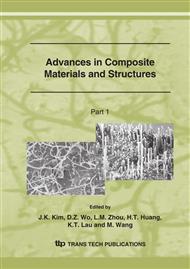p.393
p.397
p.401
p.405
p.409
p.413
p.417
p.421
p.425
Damage Characteristics of Cross Ply GFRP and Woven AFRP under Various Impact Velocities
Abstract:
Ankle Foot Orthosis (A.F.O) should endure the uncountable repeating impact and fatigue loadings due to the gait characteristics. This study investigated the impact deflection and relationship between the absorbed energy and the residual strength rate using the cross ply GFRP (glass/epoxy) and the woven AFRP (aramid/epoxy) for the leaf spring in A.F.O. In conclusion, the equation was suggested to evaluate the absorbed energy and the residual strength rate by the different impact velocities. When the cross ply GFRP and the woven AFRP was selected for the leaf spring in A.F.O, it was reasonable to use the cross ply GFRP for the parts subject to the large impact and the woven AFRP for the parts to require the high elastic energy such as the large deformation.
Info:
Periodical:
Pages:
409-412
Citation:
Online since:
March 2007
Authors:
Price:
Сopyright:
© 2007 Trans Tech Publications Ltd. All Rights Reserved
Share:
Citation:


